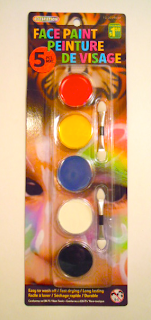For today's elephant, I decided to try hand-painting. I'd never tried this before—nor face-painting, for that matter—so I had no idea what to expect.
One of the world's foremost hand-painting artists is Guido Daniele, who makes stunning works of art. I'm not even remotely in this league, but I'll give it a go.
 |
| Hand-painting of a crocodile by Guido Daniele. Source: http://www.noupe.com/inspiration/awesome-hand-painting-art-by-guido-daniele.html |
I couldn't find instructions on hand-painting, but there are plenty on face-painting, so I adapted the technical information from those. I guessed that hand and face paints must be the same, making it only logical that the techniques should be similar.
It seemed to me that the first thing to do was to visualize the elephant. Luckily, the side of your hand between thumb and index finger is a natural canvas for an elephant. It doesn't take much to see the general shape of an elephant right away.
Next, I thought it might be a good idea if I sketched a faint outline of the general shape, so that I didn't get lost when I started applying the actual paint. At this point, I was weirdly reminded of the lips and eyes we used to draw on our hands with magic markers as kids. My "hand puppet" back then pretty much said nothing but "Alright? S'alright."
The first painting-related thing I did was cover the elephant in grey paint. "Paint" is a bit of a misnomer, because it's more like stage makeup, and doesn't blend with water. I found that the best way of applying lots of paint is with your fingers, rather than with a brush or sponge.
Even then, it looks a lot more opaque on the hand than what you see in the photograph. And it takes a stupidly long time to get even this much coverage. I began to think that hand-painters like Guido Daniele must use acrylics or some other kind of paint; but I had no idea, so I just continued with the face paints.
As you manipulate the paint in its little pots, it becomes softer, and can be applied with a brush. That's how I got the dark lines around the ears. I discovered that the brush can also be used to blend paint right on your hand, because it takes a very long time to dry. It's a bit like using oil paint. Two hours later, it's still gummy as I type this.
When I thought I had enough grey, I put in some shadows under the ear, and around the mouth. I then used a smallish brush to add a tusk, an eye and a bit of pink in the mouth.
I wasn't sure what to do about my middle knuckle, so I left it unpainted. I thought it might make the elephant look like it had a pointy head if I painted it. I deliberately didn't look at other artists' elephants before I started, because I wanted to figure it out for myself and not copy anyone. But after I finish this post, I'm definitely going to look at what others have done.
Painting on your hand is probably like painting on a rock: there's a bit of optical illusion involved. You also don't paint everything, as you can see with my thumb and index finger opened up.
On my hand, it looks quite interesting, but when it's photographed, it's surprising to see how much skin tone shows through. It was an interesting experience. If I were to do this again, however, I think I would put an undercoat of white before starting to create a canvas. And I would definitely consider using some other kind of paint.
Elephant Lore of the Day
One of the most interesting public art installations of recent years has been the Elephant Parade. Launched in 2007, the Elephant Parade has since appeared in ten cities from Rotterdam to Singapore. Each host city features at least 200 brightly coloured elephants, individually decorated by well-known artists, designers, companies and celebrities.
The life-sized Asian elephants are placed in public areas, and are meant to draw attention to the plight of Asian elephants. To date, the organization has raised more than four million euros for Asian elephants through merchandise sold online, as well as through the auction of the decorated elephants.
Artists have included Diane von Furstenburg, Isaac Mizrahi, Katy Perry, and Ferrari. For more on the Elephant Parade, visit their website at www.elephantparade.com.
 |
| One of the Elephant Parade displays in London, England in 2010 Source: www.elephantparade.com |
To Support Elephant Welfare
World Wildlife Fund
World Society for the Protection of Animals
Elephant sanctuaries (this Wikipedia list allows you to click through to information on a number of sanctuaries around the world)
Performing Animal Welfare Society
Zoocheck
Bring the Elephant Home
African Wildlife Foundation







No comments:
Post a Comment